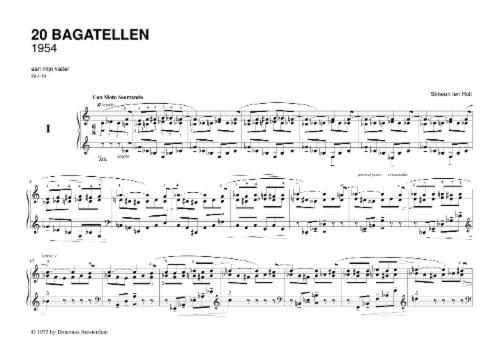20 Bagatellen

Program note :
This is a series of twenty more or less short compositions. For the first time the preference for the cycle format is shown. It is a series of pieces that are mutually related and show a relationship as far as they express the same process, a common tension.
From a music technical point of view it can be said that all parts originate from a common source in a complex of a chord, the tension of which is in search of relaxation without finding this. In the notes about the Cyclus aan de Waanzin we will come back to the phenomenon of the grasp that, per definition, turns out to be an error.
The Bagatellen are frustrated by a strong ostinato character and the centre focussed tonal structure is even more explicit than in Kompositie I. The central tone is b-flat, which plays a dominating role, but the keynote is melancholy. When outlining the spiritual make-up of this composition, we consider it as created from the relational modality of stage II.
The sounds of Kompositie I are sober and are averse to all externals. In this composition, however, the sounds are expansive and romantic. Being lost in deep thought, the inclination to start a prayer and the silence are all three replaced by the glowing whirl of life itself. The world and one’s own powers are discovered and compared. Expansion and a display of power. It is about the world, desirable and big, not as the domain of society, but as the jungle in which one, trained as a robber, is expected to find one’s way, to build a career and to maintain oneself. The subject involves his interlocutor and submits him to his own interests.
The ‘I’, too much preoccupied with the struggle for life, resigns itself to the inclusion being an inevitable theme and does not care about a system that decides about good and bad, about privilege and injustice, far beyond the limits of its observational capacities. A renaissance-like stage of life is expressed in the Bagatellen in a style that can be positioned between Chopin, Bartok and Janacek with some reminiscences of the later work of Van Domselaer.
From a symbolic point of view it can be said that the renunciation of the world as in Kompositie I makes place for the desire that is shared in the exertion of power in order to conquer the world and to confirm the materialistic character of the ‘I’.
SIMEON TEN HOLT

